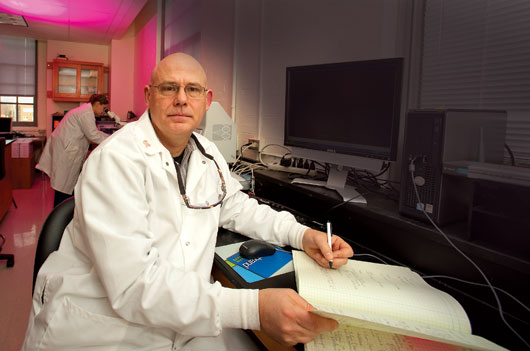Fighting a rare, but deadly, breast cancer

RESEARCH | The disease on which he focuses—inflammatory breast cancer, or IBC—is relatively rare, far less studied and much more deadly than the common form of cancer that is the subject of a great deal of scientific research, fundraising drives, media attention and public education campaigns. All those efforts have paid off in earlier detection and more effective treatment for common breast cancer, which affects the largest number of women, and van Golen wholeheartedly applauds the progress that has been made.
At the same time, the associate professor of biological sciences is concerned that less-common breast cancers are not receiving the same kinds of attention. IBC is the opposite of common breast cancer in many ways, he says, including the success of treatment: While common breast cancer now has an 80 percent survival rate, only about 20 percent of IBC patients live more than 10 years after diagnosis.
Van Golen estimates that his lab is one of just one or two dozen worldwide that are devoted to IBC research. And, at the recent San Antonio Breast Cancer Conference, the largest such gathering in the world, he says that of some 2,000 posters on view, only six were on the topic of IBC, with three of those six presented by his own students.
The disease is not only studied infrequently, but it also is often misdiagnosed at first, causing patients and physicians to lose valuable time in beginning to treat the aggressive cancer. It accounts for just 1-9 percent of breast cancer cases.
“It has none of the hallmarks of a typical cancer, either in the way it presents or in the types of treatment that are effective,” he says. “When I first encountered this disease, I was told by an oncologist: This is inflammatory breast cancer. It doesn’t follow any of the rules.”
Among the differences from common breast cancer, IBC doesn’t generally have tumors that can be felt in an exam or detected by a mammogram, and it affects younger women, occasionally even teenagers. Because the disease spreads very rapidly through the lymphatic system, treatment is aggressive and includes surgery, chemotherapy and intensive radiation therapy.
Calling the current treatments harsh and extremely difficult for patients, van Golen says, “Our approach is to figure out molecularly what’s going on with this disease and then target specific pathways” to combat it. His lab has collaborated with one in Belgium, which has established the distinctive “molecular signature” of IBC.
His lab is conducting pre-clinical trials with drugs currently used for other types of cancers, including a type of leukemia, and he hopes to partner with cancer treatment centers in the region to conduct clinical trials with patients by 2014.
Meanwhile, the key to fighting IBC is education, van Golen believes. He says that both physicians and women need to recognize the earliest symptoms of the disease and test for it so that treatment can begin immediately and have the best chance of success: “Education is the key with this disease. Education will save lives.”
Visit the IBC Foundation at www.eraseibc.com.
Article by Ann Manser, AS '73





